Weekly Reports from Jordan
Choose Year: or Choose week
Weekly Report #1
Douglas R. Clark, Author
MPP Excavations at Tall al-`Umayri, Jordan
25-27 June 2014
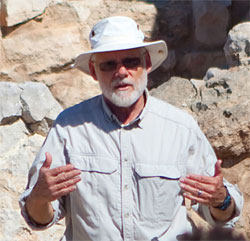 |
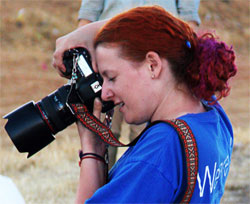 |
Discovering …
The theme of the 2014 season of excavations at the Madaba Plains Project site of Tall al-`Umayri is “Discovering …”
According to the Meriam-Webster online dictionary, here are some definitions:
dis·cov·er
verb dis-kə-vər
: to see, find, or become aware of (something) for the first time
: to show the presence of (something hidden or difficult to see) : to make (something) known
: to learn or find out (something surprising or unexpected)
dis·cov·ered dis·cov·er·ing
Full Definition of DISCOVER
transitive verb
-
a : to make known or visible : expose
b archaic : display -
a : to obtain sight or knowledge of for the first time : find <discover the solution>
b : find out <discovered he was out of gas>
intransitive verb
: to make a discovery
— dis·cov·er·able adjective
— dis·cov·er·er noun
Origin of DISCOVER
Middle English, from Anglo-French descoverir, descovrir, from Late Latin discooperire, from Latin dis- + cooperire to cover -- First Known Use: 14th century
Related to DISCOVER
Synonyms
ascertain, catch on (to), find out, get on (to), hear, learn, realize, see, wise (up), get wind of
Antonyms
miss, overlook, pass over
http://www.merriam-webster.com/dictionary/discover
With these definitions and nuances of “Discovering …” in mind, we think we have done some discovering already this summer, even through our first partial week of work at Tall al-`Umayri, Jordan.
Some examples:
We are discovering new friends.

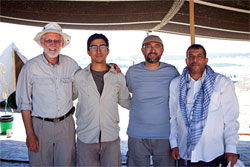 The excavation team consists of 37 intrepid excavators plus several interlopers intent on helping excavate the site during short visits (and several visiting tour groups). Participants hale from the United States, Canada, France, Brazil, the Republic of California, and Jordan. Students from La Sierra University, Walla Walla University, and Mount Royal University are registered for a total of 80 units of undergraduate and graduate credits in Archaeology and/or Biblical Studies through La Sierra. Participants short term and long include an Edinburgh University student, Tareq Judeh,
The excavation team consists of 37 intrepid excavators plus several interlopers intent on helping excavate the site during short visits (and several visiting tour groups). Participants hale from the United States, Canada, France, Brazil, the Republic of California, and Jordan. Students from La Sierra University, Walla Walla University, and Mount Royal University are registered for a total of 80 units of undergraduate and graduate credits in Archaeology and/or Biblical Studies through La Sierra. Participants short term and long include an Edinburgh University student, Tareq Judeh, 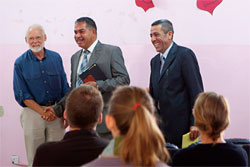 who is the son of Jordan’s current Minister of Foreign Affairs and HRH Princess Sumaya of Jordan’s royal family; two distinguished representatives of the Department of Antiquities of Jordan – Mr. Abdelrahim Al-Dwikat, and Mr. Jihad Haroun who also studies in the graduate program at La Sierra University;
who is the son of Jordan’s current Minister of Foreign Affairs and HRH Princess Sumaya of Jordan’s royal family; two distinguished representatives of the Department of Antiquities of Jordan – Mr. Abdelrahim Al-Dwikat, and Mr. Jihad Haroun who also studies in the graduate program at La Sierra University; 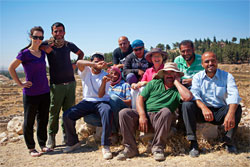 old timers with hundreds of buckets of pottery on their record; new blood in young collegiates with archaeology in their eyes (along with thick and unevenly smudged patinas of dust on their faces); those from the ages of four through around 80; mostly women, but a good stand of men; a director at `Umayri who has worked here since it began in 1984 (30 years ago – Douglas Clark), a co-director here since 1994 (20 years ago – Kent Bramlett), a husband and wife team of Field supervisor and cyber-archaeologist who met on the dig in 2004 (ten years ago – Monique and Matt Vincent). In addition, there are new administrators at the Amman Training College (ATC) where we stay while in Jordan and a cadre of long-time friends among laborers from the nearby village of Bunayat.
old timers with hundreds of buckets of pottery on their record; new blood in young collegiates with archaeology in their eyes (along with thick and unevenly smudged patinas of dust on their faces); those from the ages of four through around 80; mostly women, but a good stand of men; a director at `Umayri who has worked here since it began in 1984 (30 years ago – Douglas Clark), a co-director here since 1994 (20 years ago – Kent Bramlett), a husband and wife team of Field supervisor and cyber-archaeologist who met on the dig in 2004 (ten years ago – Monique and Matt Vincent). In addition, there are new administrators at the Amman Training College (ATC) where we stay while in Jordan and a cadre of long-time friends among laborers from the nearby village of Bunayat.
We are discovering Ramadan.
 The 30 days of Ramadan in the Middle East cycle around the year, each celebration coming about 10 days earlier than during the previous year, creating a 36-year cycle. This year the excavation season completely surrounds Ramadan. Our season runs from 25 June through 30 July, and Ramadan began on 29 June and continues until 29 July. This phenomenon has us in discovery mode much of the time. While limitations to normal dig life occur every day (restaurants are not open during the daylight hours, for example, and many businesses and government offices run on shortened schedules, and people are tired because of getting up early to eat and going to bed late, having eaten after dark), we have discovered the spirit with which serious Jordanians enter into a time of reflection on who they are before God and how to live lives of value, worth, and generosity. It takes genuine dedication. We are finding ways to continue our work while also being sensitive to those around us whose lives change drastically for a month.
The 30 days of Ramadan in the Middle East cycle around the year, each celebration coming about 10 days earlier than during the previous year, creating a 36-year cycle. This year the excavation season completely surrounds Ramadan. Our season runs from 25 June through 30 July, and Ramadan began on 29 June and continues until 29 July. This phenomenon has us in discovery mode much of the time. While limitations to normal dig life occur every day (restaurants are not open during the daylight hours, for example, and many businesses and government offices run on shortened schedules, and people are tired because of getting up early to eat and going to bed late, having eaten after dark), we have discovered the spirit with which serious Jordanians enter into a time of reflection on who they are before God and how to live lives of value, worth, and generosity. It takes genuine dedication. We are finding ways to continue our work while also being sensitive to those around us whose lives change drastically for a month.
We are discovering Iraq Al-Amir.
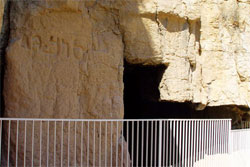
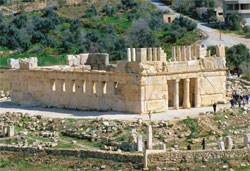 One of the most beautiful places in Jordan, west of the capital of Amman, is the Wadi Seir. Even with temperatures in the high nineties, the bus drive down, down, down into the Wadi Seir is worth it. While all is brown and dry in much of Jordan, the Wadi Seir is verdant with orchards, gardens, produce farms, vineyards, all due to the abundant flow of water toward the Jordan Valley. Once at the village of Iraq Al-Amir (Cave of the Prince), one can find several caves alongside the roadway, two of which bear the name, “Tobiah” (The Lord is Good). This is a Hebrew name, but in the book of Nehemiah, Tobiah is called “The Servant (Ebed), the Ammonite.” Turns out that Tobiah joined forces with other neighbors around Jerusalem after the Babylonian exile to prevent Jerusalem’s inhabitants from rebuilding its walls and gates. They were unsuccessful and Nehemiah won the day. Nearby the caves was the palace (Fortress? Palatial Fortress?) of Iraq Al-Amir, also and fortuitously known in Arabic as “the Servant” (Abed).
One of the most beautiful places in Jordan, west of the capital of Amman, is the Wadi Seir. Even with temperatures in the high nineties, the bus drive down, down, down into the Wadi Seir is worth it. While all is brown and dry in much of Jordan, the Wadi Seir is verdant with orchards, gardens, produce farms, vineyards, all due to the abundant flow of water toward the Jordan Valley. Once at the village of Iraq Al-Amir (Cave of the Prince), one can find several caves alongside the roadway, two of which bear the name, “Tobiah” (The Lord is Good). This is a Hebrew name, but in the book of Nehemiah, Tobiah is called “The Servant (Ebed), the Ammonite.” Turns out that Tobiah joined forces with other neighbors around Jerusalem after the Babylonian exile to prevent Jerusalem’s inhabitants from rebuilding its walls and gates. They were unsuccessful and Nehemiah won the day. Nearby the caves was the palace (Fortress? Palatial Fortress?) of Iraq Al-Amir, also and fortuitously known in Arabic as “the Servant” (Abed).
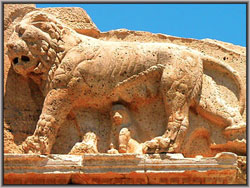 |
We are discovering Amman’s museums.
Sunday morning provided an opportunity to visit two of Amman’s main museums – the long-standing Citadel Museum and the not-entirely-opened Jordan Museum. The Citadel in central Amman has seen dramatic improvements with the display of buildings and living spaces from 4,500 years ago up to 1,500 years ago. The Citadel Museum, while small and crowded, carries a striking array of artifacts from up to 9,000 years ago to recent times. The new Jordan Museum presents Jordan’s considerable cultural heritage in stellar fashion. One floor is not yet open (Islamic history to the present), but what is on display has been put together in an organized, logical, beautifully arranged flow from earliest times through the Byzantine (Christian) Period of the 5th-7th centuries AD.
We are discovering archaeology.

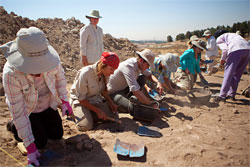 From 25 June through 27 June, the team was in orientation mode. We learned about each other, our interests and hopes for the excavation season. Newbies were discovering what it means to do archaeology, how we excavate, what we record, how we do it and for what reasons. They discovered from veterans how to live and work in the Middle East, how to respect another culture. We told stories about past experiences and helped begin a cultural immersion into the Arab world of traditions, practices, and hospitality. Orientation also took us to the three major Madaba Plains Project (MPP) sites of `Umayri, Hisban, and Jalul to capture something of the contributions of archaeological research under the auspices of MPP, one of the longest-lived archaeological expeditions in the entire Middle East, having started in 1968.
From 25 June through 27 June, the team was in orientation mode. We learned about each other, our interests and hopes for the excavation season. Newbies were discovering what it means to do archaeology, how we excavate, what we record, how we do it and for what reasons. They discovered from veterans how to live and work in the Middle East, how to respect another culture. We told stories about past experiences and helped begin a cultural immersion into the Arab world of traditions, practices, and hospitality. Orientation also took us to the three major Madaba Plains Project (MPP) sites of `Umayri, Hisban, and Jalul to capture something of the contributions of archaeological research under the auspices of MPP, one of the longest-lived archaeological expeditions in the entire Middle East, having started in 1968.
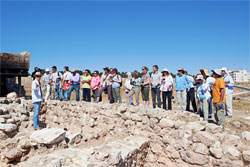 |
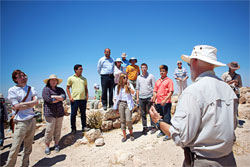 |
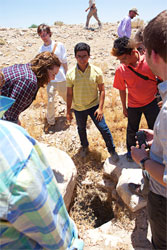 |
We are discovering a few new realities.
Given the unresolved `Umayri land-ownership issues of the past several years, we are unable to excavate on the top of the tell, where we have worked for 30 years. However, we are now opening a new field and re-opening two others. The new field, Field J, is a step trench nearly all the way down the southern slope of the site, laid out to help us understand how ancient inhabitants protected themselves. We are returning to an old field, Field K, giving our new excavations the new name of Field P. This is the area of a 5,000-year-old dolmen tomb discovered here years ago; with recent data from ground-penetrating radar in hand, we are beginning a new search for other burial installations nearby. Field H, on the edge of the top of the tell, allows us one small area for trying to understand a nearby part of the city’s defense systems over the past centuries.
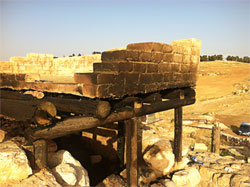
 We have also discovered, very unfortunately, that the site’s signature four-room house from 1200 BC, recently partially restored, suffered a fire which scorched several of its support posts and beams, and destroyed all of its ceiling/roof cross-branches and reeds. For safety reasons, we have closed off the part of the building covered with a partial second floor. A full report of the damage has been filed by the director of the Amman District of the Department of Antiquities, but there is nothing we can do to repair it until the land-ownership issue is resolved. This, whether accidental or not, is a setback for our ultimate plans for an outdoor archaeological park at the site.
We have also discovered, very unfortunately, that the site’s signature four-room house from 1200 BC, recently partially restored, suffered a fire which scorched several of its support posts and beams, and destroyed all of its ceiling/roof cross-branches and reeds. For safety reasons, we have closed off the part of the building covered with a partial second floor. A full report of the damage has been filed by the director of the Amman District of the Department of Antiquities, but there is nothing we can do to repair it until the land-ownership issue is resolved. This, whether accidental or not, is a setback for our ultimate plans for an outdoor archaeological park at the site.
We are discovering new technologies.
Because MPP excavations have long been recognized for their use of the latest technologies, and because of what we can learn from them, the 2014 `Umayri excavations are making use of several new toys … er … sophisticated electronic and digital research tools. Among them is a digital hand-held color-identification system which can give us precise information on the color of anything from soil to artifacts, important in the analysis of discoveries. Most prominent among these new technologies is a UAV, an octacopter, capable of carrying two cameras which will give us 3D images, both still and video. In addition, Structure From Motion photos will allow us to retrace visually and three-dimensionally the results from every day of excavation as one day’s layers of earth and architecture after another are pealed away. We will also come home with 3D video images of the entire tell and various important features of the site.
So, we are off on a discovering adventure! Please stay tuned to our weekly reports throughout the season.
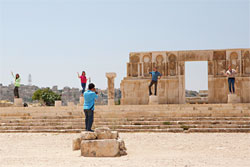 |